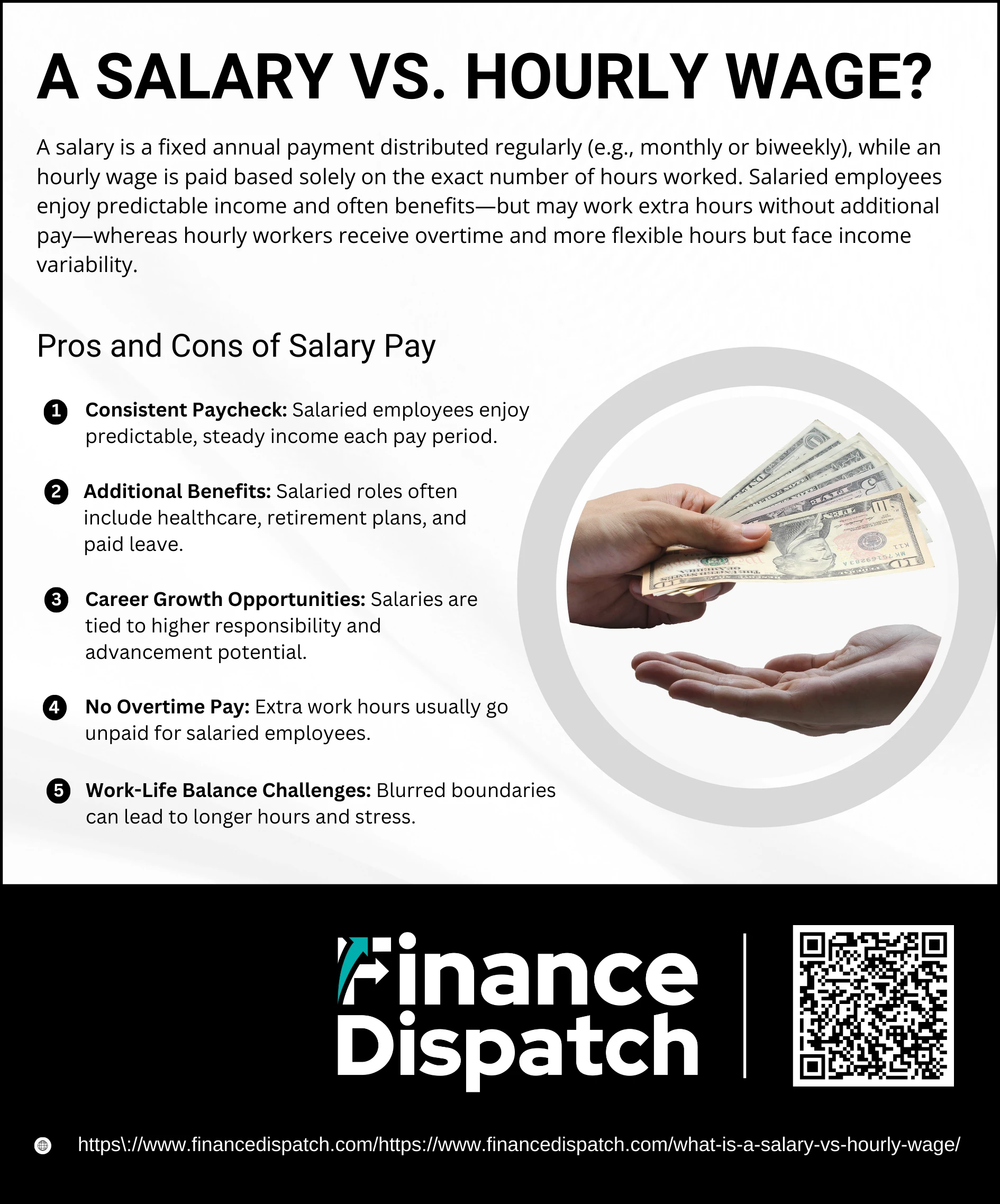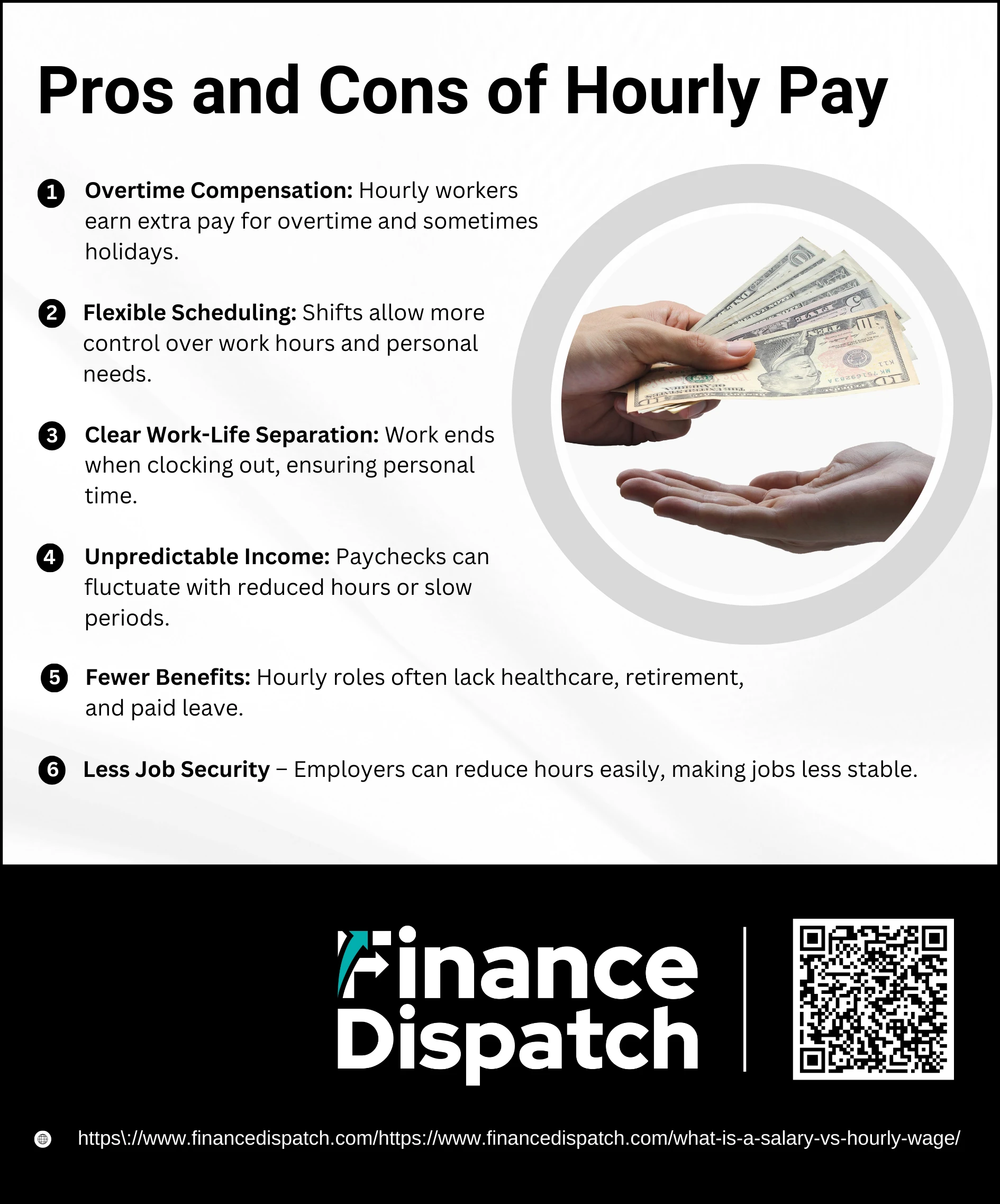When you start a new job, one of the first things you’ll notice in your offer letter is how you’ll be paid—either through a fixed salary or an hourly wage. While both are common methods of compensation, they work very differently and can influence your income stability, benefits, work-life balance, and even long-term career growth. A salary typically offers predictable pay and added perks like healthcare or paid time off, whereas an hourly wage provides flexibility and the opportunity to earn more through overtime. Understanding these distinctions is essential not only for negotiating your pay but also for choosing the type of employment that aligns with your financial goals and lifestyle needs.
What is a Salary?
A salary is a fixed amount of pay that an employee receives on a regular schedule, usually quoted as an annual figure and distributed in equal portions biweekly or monthly. Unlike hourly wages, a salary does not change based on the exact number of hours worked, meaning your paycheck remains the same even if you work longer or fewer hours in a given week. In the U.S., employees must typically earn at least $684 per week (or $35,568 per year) and perform exempt duties, such as managerial or professional tasks, to qualify as salaried workers. Salaried roles often come with additional benefits like healthcare, retirement contributions, and paid vacation. However, one drawback is that salaried employees are usually not eligible for overtime pay, which can blur the line between work and personal life when longer hours are required.
What is an Hourly Wage?
An hourly wage is the rate of pay an employee receives for each hour worked. Unlike a salary, your earnings depend directly on the number of hours you put in during a pay period, which means your paycheck can vary from week to week. For example, if you earn $17.50 per hour and work 25.5 hours, your pay would be $446.25 before taxes. Hourly employees are generally classified as non-exempt under the Fair Labor Standards Act (FLSA), which means they are entitled to overtime pay—typically time-and-a-half—for any hours worked over 40 in a week, and sometimes even double pay for holidays. While hourly work often provides flexibility and clearer boundaries between job and personal life, it can also mean fewer benefits, less job security, and income that fluctuates depending on scheduling or employer needs.
Salary vs. Hourly: Key Differences
While both salary and hourly pay are designed to compensate employees for their work, the way each is structured leads to different experiences in income stability, benefits, overtime eligibility, and job security. Understanding these differences can help you evaluate job offers more effectively and decide which pay structure better fits your financial and lifestyle needs.
| Aspect | Salary | Hourly Wage |
| Payment Structure | Fixed annual or monthly amount, same each pay period | Based on hours worked; varies by week or month |
| Overtime Pay | Usually not eligible (exempt roles) | Eligible for time-and-a-half after 40 hours, sometimes double on holidays |
| Benefits | Often includes healthcare, retirement, paid vacation, sick leave | May have limited or no benefits, depending on hours and employer |
| Job Security | More stable, harder to cut positions | Less stable, employers may reduce hours more easily |
| Work-Life Balance | May blur boundaries due to extra unpaid hours | Clearer separation; pay stops when work stops |
| Income Stability | Predictable and consistent | Can fluctuate based on hours scheduled |
 Pros and Cons of Salary Pay
Pros and Cons of Salary Pay
Salary pay provides a steady income and often comes with attractive benefits, but it isn’t always the best choice for every worker. While salaried roles typically offer stability and opportunities for advancement, they may also require longer hours without extra pay. Below are the main pros and cons explained in detail:
1. Consistent Paycheck
One of the biggest advantages of a salary is predictability. Salaried employees earn the same amount each pay period, regardless of how many hours they work. This consistency makes it easier to plan monthly budgets, pay bills on time, and manage long-term financial goals. Unlike hourly workers, salaried employees don’t have to worry about fluctuating paychecks caused by reduced hours or slow business periods.
2. Additional Benefits
Many salaried positions come with a comprehensive benefits package. These often include health insurance, retirement contributions (such as a 401(k) match), paid vacation, sick days, and sometimes extras like childcare support or gym memberships. Even if the salary is slightly lower than an hourly equivalent, the value of these benefits can make the overall compensation package more rewarding.
3. Career Growth Opportunities
Salaried jobs are usually tied to higher levels of responsibility, which can open doors to career advancement. Positions such as management, professional, or administrative roles often require salaried employment, and these roles tend to offer clearer promotion paths. Over time, being in a salaried role can make it easier to climb the career ladder compared to staying in an hourly position.
4. No Overtime Pay
The biggest drawback of salary pay is that extra work hours typically go uncompensated. Exempt salaried employees may be expected to work late nights, weekends, or holidays to complete projects without earning additional pay. While this allows employers to save on overtime costs, it means workers often put in more hours than they are technically paid for.
5. Work-Life Balance Challenges
Because salaried roles come with set goals and performance expectations, employees may feel pressure to be constantly available. The lack of a strict “clock out” time can blur the line between personal and professional life. For example, answering emails during evenings or handling urgent tasks over the weekend can become a regular part of the job, leading to stress and burnout if not managed carefully.
 Pros and Cons of Hourly Pay
Pros and Cons of Hourly Pay
Hourly pay compensates workers for every hour they put in, making it one of the most straightforward and transparent payment systems. For some, the ability to earn more through overtime and to clearly separate work from personal life is a big advantage. For others, the inconsistency in hours and limited benefits can be a challenge. Below are the detailed pros and cons of hourly pay:
1. Overtime Compensation
One of the strongest advantages of hourly pay is eligibility for overtime. Under federal labor law, hourly employees who work more than 40 hours in a week are entitled to at least time-and-a-half, which can add up quickly. For example, someone earning $20 per hour would receive $30 per hour for overtime work. Some employers even offer double or triple pay on holidays, allowing hourly workers to boost their income significantly during peak times.
2. Flexible Scheduling
Hourly jobs often provide more flexibility compared to salaried roles. Employees may work part-time, seasonal, or variable shifts depending on their needs. This flexibility is ideal for students balancing school, parents managing childcare, or individuals exploring side businesses. Being able to accept or decline shifts gives workers greater control over how much they work and when.
3. Clear Work-Life Separation
Once an hourly employee clocks out, the expectation to keep working ends. Unlike many salaried roles, there’s little to no pressure to answer calls, respond to emails, or handle tasks outside scheduled hours. This clear boundary makes it easier to enjoy personal time, focus on hobbies, or spend time with family without work spilling into home life.
4. Unpredictable Income
A downside of hourly pay is that earnings can fluctuate. During slow seasons, employers may cut hours, leaving workers with smaller paychecks. For example, someone used to working 40 hours may suddenly be scheduled for only 25, resulting in a sharp drop in income. This lack of predictability can make it difficult to cover fixed expenses like rent or car payments and often requires workers to save more aggressively during busy periods.
5. Fewer Benefits
Many hourly jobs—especially part-time ones—do not come with standard employee benefits such as health insurance, retirement contributions, paid vacation, or sick leave. Workers may need to buy private insurance or go without coverage, which can be expensive and stressful. Compared to salaried positions that often include comprehensive benefits, hourly workers may feel financially disadvantaged even if their base pay seems competitive.
6. Less Job Security
Hourly employees are often the first to feel the effects of cost-cutting measures. Employers can reduce hours more easily than they can eliminate salaried positions. For instance, in times of economic downturn or when business slows, companies may simply cut hourly shifts instead of laying off full-time salaried staff. This makes hourly roles more vulnerable to sudden changes, leaving workers with less security and stability.
Real-World Insights: Average Earnings
Looking at national income data helps put the salary versus hourly debate into perspective. According to the U.S. Bureau of Labor Statistics (BLS), American workers earned a median income of $1,165 per week in the third quarter of 2024. This figure includes both salaried and hourly employees, showing the broad middle ground of earnings across the workforce. However, the data also highlights differences by gender—women earned a median of $1,054 per week, which is 83.4% of the $1,264 median for men. These statistics emphasize how income can vary not only by pay structure but also by demographic and industry, making it important for workers to evaluate their total compensation, benefits, and earning potential when comparing salary and hourly roles.
Conclusion
Both salary and hourly pay come with their own advantages and challenges, and the better option depends on your personal goals, lifestyle, and career path. Salaried positions often provide stability, benefits, and long-term growth opportunities, but they may demand longer hours without extra pay. Hourly roles, on the other hand, reward you for every hour worked and can offer greater flexibility, though they may lack consistent income and benefits. By understanding these key differences, you can make informed decisions when evaluating job offers or negotiating compensation, ensuring that your choice aligns with both your financial needs and work-life balance.



